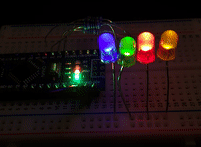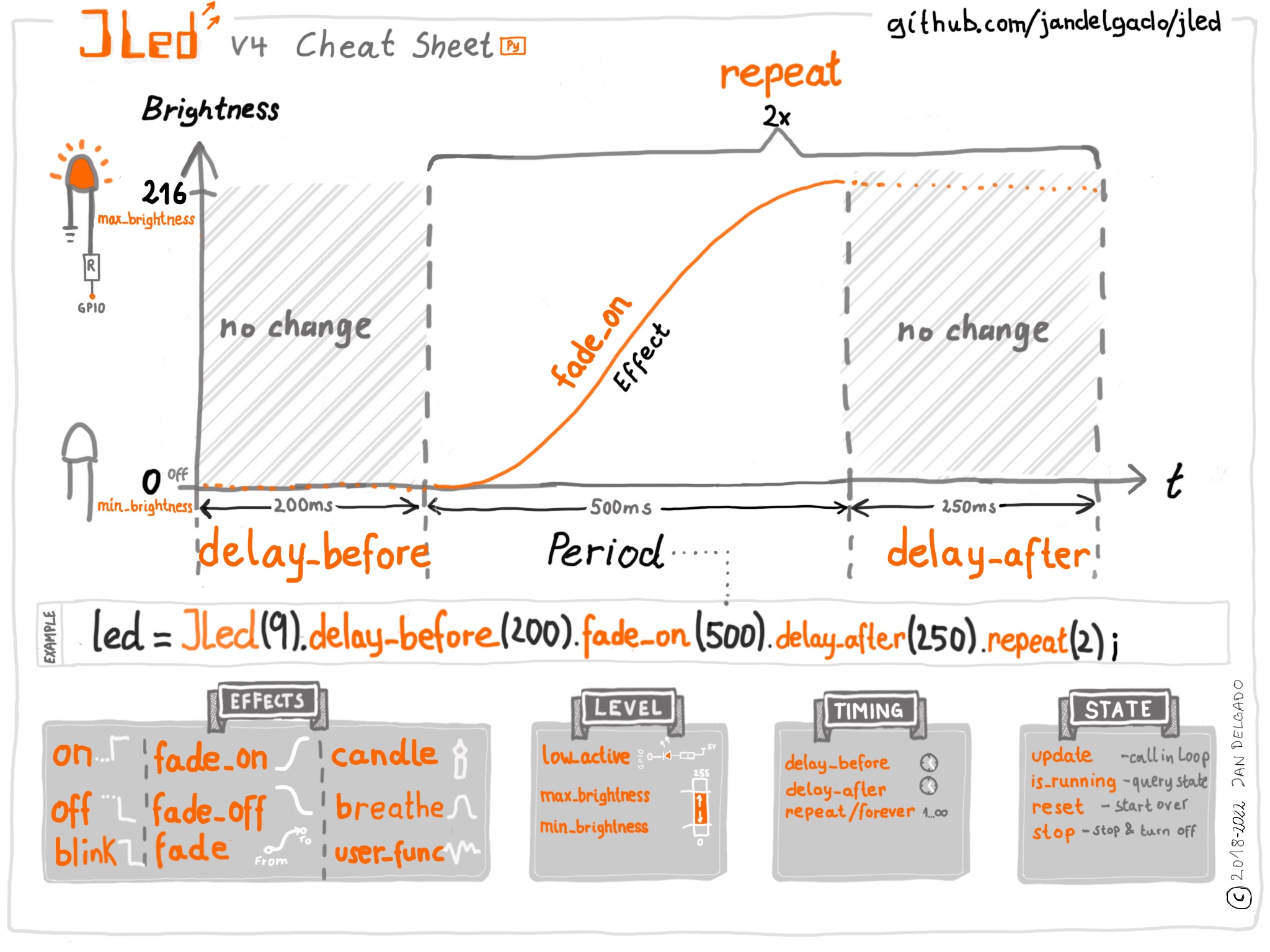Non-blocking LED controlling library
Project description
Introduction



An embedded library for Python to control LEDs. It uses a non-blocking approach and can control LEDs in simple (on/off) and complex (blinking, breathing and more) ways in a time-driven manner.
This is a pure Python port of my JLed C++ library.

Features
non-blocking
effects: simple on/off, breathe, blink, candle, fade, user-defined
supports inverted polarity of LED
easy configuration using fluent interface
can control groups of LEDs sequentially or in parallel
supports CircuitPython and MicroPython
Usage Example
Test JLed interactively in a CircuitPython REPL:
Adafruit CircuitPython 7.3.3 on 2022-08-29; Raspberry Pi Pico with rp2040
>>> import board
>>> from jled import JLed
>>> led=JLed(board.LED).breathe(500).delay_after(250).repeat(5)
>>> while led.update(): passThis creates a JLed object connected to the builtin LED (board.LED), with a breathe effect that is repeated 5 times. Each iteration is followed by a delay of 250 ms, before starting again. By calling led.update() periodically, the LED gets physically updated. Alternatively play(led) can be call in the REPL as a shortcut. Once finished, call led.reset() before playing the effect again.
Cheat Sheet

Installation
On supported GNU/Linux systems like the Raspberry Pi (with Adafruit-Blinka), you can install the lib locally from PyPI. To install for current user:
pip3 install circuitpython-jledTo install system-wide (this may be required in some cases):
sudo pip3 install circuitpython-jledTo install in a virtual environment in your current project:
mkdir project-name && cd project-name
python3 -m venv .venv
source .env/bin/activate
pip3 install circuitpython-jledInstalling to a Connected CircuitPython Device with Circup
JLed is available in the Circuitpython Community Bundle and can easily installed with circup by running:
$ circup install jled
Optionally copy also one of the example as code.py to the root of the filesystem.
Installing on a MicroPython device
Create a directory called jled on the device and copy the following files into this directory: into this directory: jled.py, jled_sequence.py hal_pwm_micropython.py, hal_time_micropython.py, play.py, __init__.py`. Optionally also copy one of the example as main.py to the root of the filesystem. The overall structure is:
/
├─ main.py
└─ jled
├─ __init__.[m]py
├─ hal_pwm_micropython.[m]py
├─ hal_time_micropython.[m]py
├─ jled.[m]py
├─ jled_sequence.[m]py
└─ play.[m]pyTo reduce memory consumption, Python source files can be compiled to binary mpy format using the mpy-cross tool. For convenience, a script to compile and copy jled to a connected device is provided here (see scripts/install_mp.sh).
Documentation
API documentation for this library can be found on here.
Rebuild the documentation with sphinx-build -E -W -b html . _build/html in the docs directory. Run pip install ".[optional]" before to install build-time dependency Sphinx
Tests
Unit tests (using https://docs.pytest.org) are provided, run the tests with:
$ pip install ".[optional]"
$ pytestTo run the pre-commit-hook locally, run pre-commit run --all-files
Project details
Download files
Download the file for your platform. If you're not sure which to choose, learn more about installing packages.
Source Distribution
Built Distribution
Hashes for circuitpython_jled-1.0.4-py3-none-any.whl
| Algorithm | Hash digest | |
|---|---|---|
| SHA256 | 6e313bb288677e126b5d10eb7a751fb4540d020325a3970a25223503dd8ae4b7 |
|
| MD5 | cf06e4ff5c7f0330d2a1d0ad4301077b |
|
| BLAKE2b-256 | 39bbb835f3d1c60954339b0c4a6aae2619627445253934368f233e39a28a1117 |











